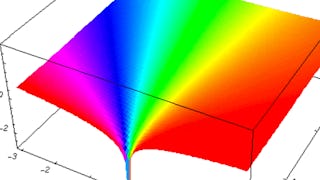After completing this course, students will learn how to successfully apply functions to model different data and real world occurrences. This course reviews the concept of a function and then provide multiple examples of common and uncommon types of functions used in a variety of disciplines. Formulas, domains, ranges, graphs, intercepts, and fundamental behavior are all analyzed using both algebraic and analytic techniques. From this core set of functions, new functions are created by arithmetic operations and function composition. These functions are then applied to solve real world problems. The ability to picture many different types of functions will help students learn how and when to apply these functions, as well as give students the geometric intuition to understand the algebraic techniques. The skills and objectives from this course improve problem solving abilities.

Ends tomorrow: Get a Black Friday boost with $160 off 10,000+ programs. Save now.


Algebra: Elementary to Advanced - Functions & Applications
This course is part of Algebra: Elementary to Advanced Specialization

Instructor: Joseph W. Cutrone, PhD
Top Instructor
13,192 already enrolled
Included with
(191 reviews)
Skills you'll gain
Details to know

Add to your LinkedIn profile
5 assignments
See how employees at top companies are mastering in-demand skills

Build your subject-matter expertise
- Learn new concepts from industry experts
- Gain a foundational understanding of a subject or tool
- Develop job-relevant skills with hands-on projects
- Earn a shareable career certificate

There are 3 modules in this course
A linear relationship between two variables occurs when there is a constant increase or constant decrease in one variable with respect to the other. Linear functions have the property that any chance in the independent variable results in a proportional change in the dependent variable. Many physical situations can be modeled using a linear relationship. Adding an extra term of the form ax^2 to a linear function creates a quadratic function, and its graph is the parabola. We will see examples of linear and quadratic functions and their applications in the sections that follow.
What's included
2 videos5 readings2 assignments
In the last module we introduced the important concept of a function and considered the linear and quadratic functions. In this module, we discuss methods for building new functions from those that are already familiar to use. One method will use the graph shifting techniques already introduced. These methods are developed further and applied to new functions. Constructing a graph is often an important first step in solving a problem. The more functions you can picture, the better problem solver you will be.
What's included
3 videos5 readings2 assignments
Congratulations on reaching the final exam! This final assessment will be cumulative in nature, covering all aspects of the course. Use this final as a teaching tool: justify what you know and identify areas for improvement. Use scrap paper as you take this final. Try to use any formula sheets or outside resources as a tool and not a crutch. Check your answers before you submit. After the test, review any incorrect answers to find your mistakes. Try to separate "silly" mistakes from the more substantial mistakes in understanding. Good luck!
What's included
1 assignment
Earn a career certificate
Add this credential to your LinkedIn profile, resume, or CV. Share it on social media and in your performance review.
Instructor

Offered by
Explore more from Math and Logic
 Status: Free Trial
Status: Free TrialJohns Hopkins University
 Status: Free Trial
Status: Free TrialJohns Hopkins University
 Status: Free Trial
Status: Free TrialJohns Hopkins University
 Status: Free Trial
Status: Free TrialJohns Hopkins University
Why people choose Coursera for their career




Learner reviews
191 reviews
- 5 stars
85.86%
- 4 stars
9.94%
- 3 stars
2.09%
- 2 stars
1.04%
- 1 star
1.04%
Showing 3 of 191
Reviewed on Feb 1, 2023
this course is a very good , citica and knowledgeable course .
Reviewed on Sep 5, 2022
good. but with frequent lacunae. stuff doesn't get comprehensively explained and/or demonstrated
Reviewed on Aug 7, 2021
The best Thank you so much for this very easy explanation for lessons

Open new doors with Coursera Plus
Unlimited access to 10,000+ world-class courses, hands-on projects, and job-ready certificate programs - all included in your subscription
Advance your career with an online degree
Earn a degree from world-class universities - 100% online
Join over 3,400 global companies that choose Coursera for Business
Upskill your employees to excel in the digital economy
Frequently asked questions
To access the course materials, assignments and to earn a Certificate, you will need to purchase the Certificate experience when you enroll in a course. You can try a Free Trial instead, or apply for Financial Aid. The course may offer 'Full Course, No Certificate' instead. This option lets you see all course materials, submit required assessments, and get a final grade. This also means that you will not be able to purchase a Certificate experience.
When you enroll in the course, you get access to all of the courses in the Specialization, and you earn a certificate when you complete the work. Your electronic Certificate will be added to your Accomplishments page - from there, you can print your Certificate or add it to your LinkedIn profile.
Yes. In select learning programs, you can apply for financial aid or a scholarship if you can’t afford the enrollment fee. If fin aid or scholarship is available for your learning program selection, you’ll find a link to apply on the description page.
More questions
Financial aid available,

